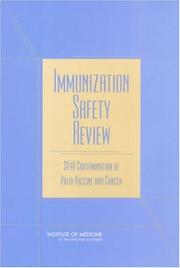| Listing 1 - 10 of 19 | << page >> |
Sort by
|
Book
Year: 2018 Publisher: Basel : MDPI - Multidisciplinary Digital Publishing Institute,
Abstract | Keywords | Export | Availability | Bookmark
 Loading...
Loading...Choose an application
- Reference Manager
- EndNote
- RefWorks (Direct export to RefWorks)
The interest in human polyomaviruses (HPyV) has seen a renaissance because of new species that have been isolated and their previously unknown association with diseases. Likewise, the increasing evidence for the association of human papillomaviruses (HPV) with oropharyngeal cancer has sparked the attention of researchers and clinicians. The Special Issue "Human Polyomaviruses and Papillomaviruses" presents studies describing the nuclear egress of BK polyomavirus mediated by the viral agnoprotein and the cellular a-SNAP protein. In addition, a study examines the promoter activity of two different variants of human polyomavirus 9 in different cell lines. This Special Issue offers an interesting perspective on the epidemiology of HR-HPV in different cancers and on the mechanisms by which these viruses target host cell proteins to replicate their genome, express their genes, interfere with autophagy, and induce cancer. Other topics that are highlighted include the role of co-factors, such as smoking and co-infection, novel therapeutic strategies, and surface immunoregulatory proteins, chemokines, and cytokines as possible biomarkers to determine the stage of a tumor and to predict clinical outcomes.
Book
Year: 2018 Publisher: Basel : MDPI - Multidisciplinary Digital Publishing Institute,
Abstract | Keywords | Export | Availability | Bookmark
 Loading...
Loading...Choose an application
- Reference Manager
- EndNote
- RefWorks (Direct export to RefWorks)
The interest in human polyomaviruses (HPyV) has seen a renaissance because of new species that have been isolated and their previously unknown association with diseases. Likewise, the increasing evidence for the association of human papillomaviruses (HPV) with oropharyngeal cancer has sparked the attention of researchers and clinicians. The Special Issue "Human Polyomaviruses and Papillomaviruses" presents studies describing the nuclear egress of BK polyomavirus mediated by the viral agnoprotein and the cellular a-SNAP protein. In addition, a study examines the promoter activity of two different variants of human polyomavirus 9 in different cell lines. This Special Issue offers an interesting perspective on the epidemiology of HR-HPV in different cancers and on the mechanisms by which these viruses target host cell proteins to replicate their genome, express their genes, interfere with autophagy, and induce cancer. Other topics that are highlighted include the role of co-factors, such as smoking and co-infection, novel therapeutic strategies, and surface immunoregulatory proteins, chemokines, and cytokines as possible biomarkers to determine the stage of a tumor and to predict clinical outcomes.
Book
Year: 2018 Publisher: Basel : MDPI - Multidisciplinary Digital Publishing Institute,
Abstract | Keywords | Export | Availability | Bookmark
 Loading...
Loading...Choose an application
- Reference Manager
- EndNote
- RefWorks (Direct export to RefWorks)
The interest in human polyomaviruses (HPyV) has seen a renaissance because of new species that have been isolated and their previously unknown association with diseases. Likewise, the increasing evidence for the association of human papillomaviruses (HPV) with oropharyngeal cancer has sparked the attention of researchers and clinicians. The Special Issue "Human Polyomaviruses and Papillomaviruses" presents studies describing the nuclear egress of BK polyomavirus mediated by the viral agnoprotein and the cellular a-SNAP protein. In addition, a study examines the promoter activity of two different variants of human polyomavirus 9 in different cell lines. This Special Issue offers an interesting perspective on the epidemiology of HR-HPV in different cancers and on the mechanisms by which these viruses target host cell proteins to replicate their genome, express their genes, interfere with autophagy, and induce cancer. Other topics that are highlighted include the role of co-factors, such as smoking and co-infection, novel therapeutic strategies, and surface immunoregulatory proteins, chemokines, and cytokines as possible biomarkers to determine the stage of a tumor and to predict clinical outcomes.
Dissertation
Year: 1980 Publisher: Epalinges Impr. La Concorde
Abstract | Keywords | Export | Availability | Bookmark
 Loading...
Loading...Choose an application
- Reference Manager
- EndNote
- RefWorks (Direct export to RefWorks)
Dissertation
Abstract | Keywords | Export | Availability | Bookmark
 Loading...
Loading...Choose an application
- Reference Manager
- EndNote
- RefWorks (Direct export to RefWorks)
BK Virus --- Polyomavirus --- Tonsillitis --- isolation & purification --- microbiology
Dissertation
Abstract | Keywords | Export | Availability | Bookmark
 Loading...
Loading...Choose an application
- Reference Manager
- EndNote
- RefWorks (Direct export to RefWorks)
Polyomavirus --- Blood --- Cattle --- DNA, Viral --- Genes, Viral --- isolation & purification --- microbiology --- blood
Book
Year: 1963 Publisher: Leuven Uitgeverij " Nauwelaerts "
Abstract | Keywords | Export | Availability | Bookmark
 Loading...
Loading...Choose an application
- Reference Manager
- EndNote
- RefWorks (Direct export to RefWorks)
Geneeskunde en aanverwante wetenschappen --- Médecine et sciences connexes --- Sciences appliquées --- Toegepaste wetenschappen --- Polyomavirus --- Virus polyome --- 616-006.46-022.6

ISBN: 128093560X 9786610935604 0387329579 0387292330 1441921222 Year: 2006 Publisher: New York, N.Y. : Georgetown, Tex. : Springer Science+Business Media ; Eurekah.com/Landes Bioscience,
Abstract | Keywords | Export | Availability | Bookmark
 Loading...
Loading...Choose an application
- Reference Manager
- EndNote
- RefWorks (Direct export to RefWorks)
Science never solves apr oblem without creating ten more Geor ge Bernard Shaw How prophetic the above words prove to be when applied to the advances of 20th century medicine. Prior to Banting and Best, chnicians were unaware of the ravages of diabetes, patients simply wasted away and died. Following the purifica tion of insulin, clinicians now had to deal with diabetic retinopathy, diabetic neph ropathy and all the other complications of long-term diabetes. A little over 50 years ago, the first successful human kidney transplant was performed in Boston. The first 30 years of the experience had successes when compared to the alternative but were a constant struggle to get even 50% of the grafts from deceased donors to survive more than a year. However, the science continued to advance knowledge of the immune response. With this came more and increasingly powerful tools for the clinician. Suddenly, success rates of 80-90% at one year were attainable. With this success came new problems, new complications and clinicians now had to worry about the long-term consequences of their therapy as patients were surviving with functional grafts for extended periods. A particular infectious complication evolved with the application of ever more powerful immunosuppressant drugs. Astute clinicians noted that occasionally cellular rejections seemed to get worse with steroids. Despite their best efforts and the use of powerful drugs, patients lost their grafts to overwhelming interstitial infiltrates not seen before.
Polyomavirus infections. --- Polyomaviruses. --- Papovaviruses --- Polyoma virus --- Polyomavirus --- Polyomaviridae --- Oncogenic DNA viruses --- Polyomavirus diseases --- Virus diseases --- Immunology. --- Emerging infectious diseases. --- Pathology. --- Neurology. --- Oncology . --- Infectious Diseases. --- Oncology. --- Tumors --- Medicine --- Nervous system --- Neuropsychiatry --- Disease (Pathology) --- Medical sciences --- Diseases --- Medicine, Preventive --- Emerging infections --- New infectious diseases --- Re-emerging infectious diseases --- Reemerging infectious diseases --- Communicable diseases --- Immunobiology --- Life sciences --- Serology --- Infectious diseases. --- Neurology . --- Communicable diseases. --- Contagion and contagious diseases --- Contagious diseases --- Infectious diseases --- Microbial diseases in human beings --- Zymotic diseases --- Infection --- Epidemics

ISBN: 0309086108 9786610183074 1280183071 030956638X 9780309517171 0309517176 9780309566384 9780309086103 9781280183072 6610183074 0309168910 9780309168915 Year: 2003 Publisher: Washington, D.C. National Academies Press
Abstract | Keywords | Export | Availability | Bookmark
 Loading...
Loading...Choose an application
- Reference Manager
- EndNote
- RefWorks (Direct export to RefWorks)
Electronic books. -- local. --- Immunization -- Complications. --- Poliomyelitis vaccine -- Contamination. --- Vaccination -- Complications. --- Poliomyelitis vaccine --- Immunization --- Vaccination --- Health Policy --- Poliovirus Vaccines --- Simian virus 40 --- Drug Contamination --- Neoplasms --- United States --- Polyomavirus --- Immunologic Techniques --- Public Policy --- Immunotherapy --- Communicable Disease Control --- Primary Prevention --- Public Health --- Viral Vaccines --- Immunotherapy, Active --- North America --- Diseases --- Environment and Public Health --- Public Health Practice --- Social Control Policies --- Preventive Health Services --- Investigative Techniques --- Americas --- Immunomodulation --- Polyomaviridae --- Vaccines --- Biological Products --- Health Care --- Social Control, Formal --- Policy --- DNA Viruses --- Geographic Locations --- Health Services --- Analytical, Diagnostic and Therapeutic Techniques and Equipment --- Biological Therapy --- Social Sciences --- Health Care Facilities, Manpower, and Services --- Sociology --- Therapeutics --- Geographicals --- Health Care Economics and Organizations --- Complex Mixtures --- Viruses --- Anthropology, Education, Sociology and Social Phenomena --- Organisms --- Chemicals and Drugs --- Public Health - General --- Health & Biological Sciences --- Contamination --- Complications --- Contamination. --- Complications. --- Complications and sequelae --- Side effects --- Contamination (Technology)
Book
Year: 2021 Publisher: Basel, Switzerland MDPI - Multidisciplinary Digital Publishing Institute
Abstract | Keywords | Export | Availability | Bookmark
 Loading...
Loading...Choose an application
- Reference Manager
- EndNote
- RefWorks (Direct export to RefWorks)
This book provides important and updated information on current research devoted to urinary biomarkers. Urinary biomarkers are characteristics that can be objectively measured and evaluated as indicators of normal biological or pathogenic processes of pharmacological responses to therapeutic intervention.
Medicine --- poststreptococcal acute glomerulonephritis --- infection-related glomerulonephritis --- nephritis-associated plasmin receptor --- plasmin --- acute kidney injury --- renal biomarkers --- furosemide stress test --- functional assessment --- urine --- diabetic kidney disease --- kidney function --- proteomics --- mass spectrometry --- statistical clinical model --- machine learning --- acute tubulointerstitial nephritis --- immunology --- biomarkers --- chronic kidney disease --- differential diagnosis --- label-free quantification --- renal transplant --- extracellular vesicles --- acute rejection --- chronic rejection --- chronic allograft dysfunction --- calcineurin-inhibitor nephrotoxicity --- Polyomavirus associated nephropathy --- immunosuppression --- upper urinary tract obstruction --- kidney injury --- neutrophil gelatinase-associated lipocalin --- monocyte chemotactic protein-1 --- kidney injury molecule 1 --- cystatin C --- vanin-1 --- microRNA --- uromodulin --- kidney graft function --- biomarker --- kidney transplantation --- long noncoding RNA --- rejection --- microvascular injury --- urinary aminopeptidases --- arterial hypertension --- renal function --- urinary biomarkers --- markers of AKI --- cystatin-C --- NGAL --- KIM-1 --- exercise --- end-stage kidney disease (ESKD) --- cardiovascular disease --- epidemiology --- CKD --- macrophage subpopulation --- renal fibrosis --- trichostatin A --- kidney graft --- T-cell-mediated rejection --- antibody-mediated rejection --- diagnostic test accuracy --- gentamicin --- sepsis --- miRNA --- nephrotoxicity --- vancomycin --- n/a
| Listing 1 - 10 of 19 | << page >> |
Sort by
|

 Search
Search Feedback
Feedback About UniCat
About UniCat  Help
Help News
News